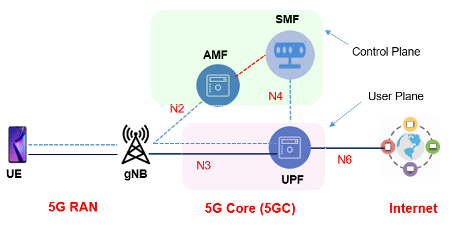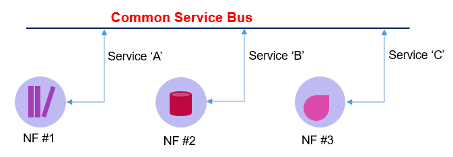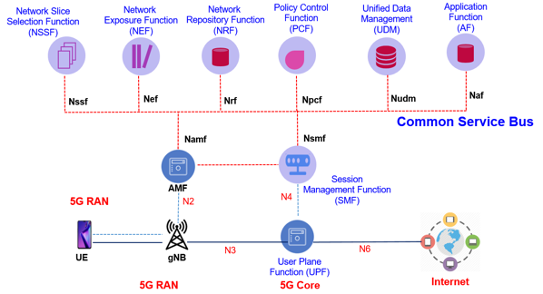A 5G System (5GS) consists of User Equipment (UE), 5G Base station (gNB), 5G and a 5G Core Network (5GC) as illustrated in following Figure 1. In 5GS architecture, the 5GC is located at heart and enables the 5G RAN to support 3GPP defined three use cases, i.e. Enhanced Mobile Broadband (eMBB), Ultra-Reliable Low Latency Communication (URLCC) and Massive Machine Type Communication (mMTC).

3GPP has defined 5G Core to utilize cloud virtualisation, service-based architecture (SBA) across all 5G functions and procedures, including authentication, security, session management and aggregation of traffic from end devices. The 5G core network supports the Virtualization of software functions to use NFVI in design 5G Networks, including MEC infrastructure. The new architecture has adopted separation of user plane and control plane functions, which enables independent scaling of the control and user plane functions, e.g. a Mobile Network Operator (MNO) can add more user plane functions without adding more control plane and vice versa depending on deployment strategies. User plane functions could be distributed geographically close to 5G RAN to minimise user plane latency, while control plane functions could be centralised to get benefits of Virtualization.
3GPP has defined ‘Reference Point Architecture’ and ‘Service Based Architecture’. In “Reference Point Architecture” the Network Elements (NEs) use point-to-point interfaces to inter-connect each other. Each point-to-point interface has specified certain signalling protocols and procedures.

In ‘Service based’ architecture, the set of Network Elements (NEs) are replaced with a set of Network Functions (NFs). Each Network Function can provide services to other Network Functions, i.e. each Network Function is a service provider. The point-to-point interfaces are replaced by a common bus which inter-connects all Network Functions. The services are specified for the Network Function providing them, instead of each pair providing and consuming Network.

Service Based 5G System Architecture
5G System Service Based architecture is illustrated in Figure 4. This architecture includes a set of Network Functions (NFs), and a common bus known as a service bus to inter-connect the Network Functions. The Service Based architecture is applicable to the control plane, and Reference Point architecture is used for the user plane of the 5G Core Network.
The interface naming for the Reference point is given as a number with the letter “N” like N2, N3 or N4. N2 is the logical reference point between gNB and AMF, whereas N3 is a reference point between gNB and UPF. The naming for service based interface includes network function name with the letter “N,” e.g. Namf is the interface between AMF network function and Common Service Bus.
The Network Repository Function (NRF) is the main network function in service based architecture and plays a key role. All network functions register the services they offer with the NRF using service registration procedure, and later they use the NRF as a database to discover the services offered by other Network with service discovery and service authorization procedure.

Within Service Based Architecture, Network Functions communicate to each other using http protocols defined methods like POST, GET, PUT, PATCH and DELETE.
The Service Based architecture represents a move towards a cloud implementation of the Core Network. Legacy Core Networks have been deployed using separate hardware for each Network Element. Today 5G Core Networks use cloud-native network functions (CNF). Microservices and CNFs provide better resource efficiency, resiliency and higher availability. CNF also promises less downtime in the network.
Cubro offers an advanced solution to extract data out of the 5G SBI bus, even when the TLS 1.3 ciphering is used.
